Listen, I love playing with a live drummer. Some of my best musical partnerships have been with amazing drummers. But I love how Logic Pro gives me a virtual live drummer to inspire me and help turn my rhythmic ideas into reality.
Playing with your virtual drummer
Drummer is your virtual session player. Drummer is a combination of track type and software instrument. The track type does the drumming, and the software instrument provides the drum sounds. A drummer track is a particular track type reserved for use with Drummer.The drummer track comes with its own drummer editor, which chooses the style of music and the player, and tells the drummer how to play the track. The editor is so simple that anyone can use it.
The Drum Kit Designer or Drum Machine Designer software instrument is automatically added to a drummer track, depending on your drummer selection. (Note that you don't have to use the preloaded software instrument.) Drummer works the same for both software instruments, so I won’t describe them separately in this article.
Creating a drummer track
To create a drummer track, choose Track → New Drummer Track. A new drummer track is added to the track list, and a default eight-bar region is added to the tracks area, as shown in the figure below.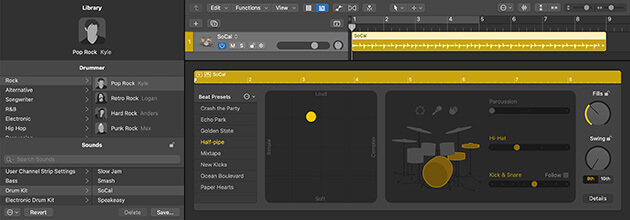 ©Logic Pro
©Logic ProA drummer track and region
Creating drummer regions
Although Drummer automatically creates an eight-bar region, you don’t have to live with it. By using several regions to build your project rather than one big region, you can more easily change what your drummer plays during different song sections (as you’ll soon see).To create a drummer region, select the pencil tool in the tracks area and click where you would like the region to begin. By default, drummer regions are eight bars long. If you want to change the region's size, drag the region's lower-left or lower-right edge to resize it. You could also split a region (making two regions out of one) by using the scissors tool.
If you want to force the drummer to hit the crash cymbal at the beginning of a song section, create a new region. You may need to adjust the Fills parameter, as you learn next, but getting Drummer to play a cymbal crash at the beginning of a region is a good reason why you want new regions to start at song sections or groove changes.
Choosing and directing your drummer in the editor
The real power of Drummer’s artificial intelligence-like personality is in the drummer editor. To open the editor, double-click a drummer region or select the region and choose View → Show Editor (E). The editor, shown in the figure below, opens at the bottom of the tracks area. ©Logic Pro
©Logic ProThe drummer editor
The drummer editor is filled with personality. To get the most out of it, open the library (press Y or choose View → Show Library) so you can change settings for the entire drummer track. At the top of the area is a headshot and description of the currently selected drummer character, as shown in the figure below.
Below the current drummer is the Drummer section, where you can choose the style and drummer character. Each style has several different drummers with names and headshots, and new drummers are occasionally added with software updates. Click the drummer you want for the entire track. The track regions and drummer editor are updated with the style of the selected drummer.
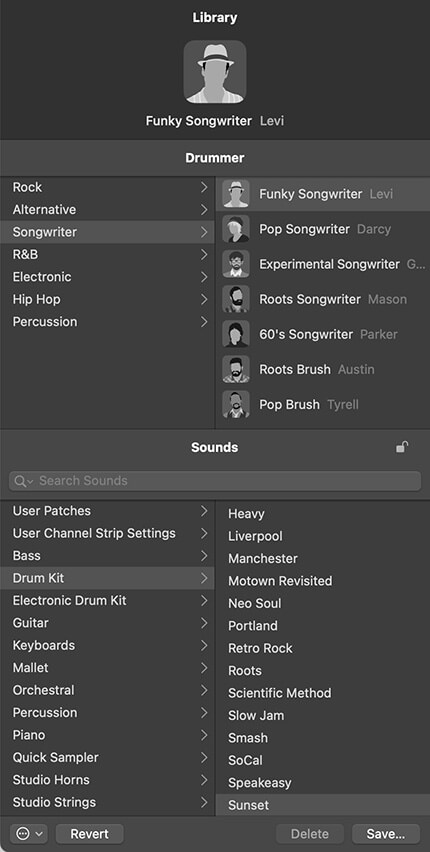 ©Logic Pro
©Logic ProThe drummer library
Below the drummer character focus area is the Sounds section. Although each drummer character has an associated kit, you can choose different kits independently of the selected drummer character. Click the lock icon next to the Sounds heading to change drummers without changing drum kits. Since Logic Pro first came out, developers have added new drummers and kits, and more are bound to be on the way.
The drummer editor is where you change settings for the selected drummer region. Here’s a description of each section:
- Ruler: At the top of the region settings are a ruler, a play icon, and an auto-select icon. You can play the region or move the playhead within the region in this ruler. When auto-select is engaged, the drummer editor displays settings for the region at the current playhead position.
- Beat Presets: Choosing a drummer character loads a set of beat presets you can click to update the editor controls. At the top of the Presets menu is a drop-down list where you can save, delete, and recall the default preset. You can also refresh the region to make subtle changes to the current region. Finally, you can choose to keep the settings while changing drummers.
- X/Y pad: The X/Y pad has a yellow puck that you can move between Loud/Soft and Complex/Simple. The position of the puck makes a big difference in the beat the drummer will play.
- Drum and percussion instruments: Click the instruments to select the drum and percussion sounds that will play in the region. Depending on the selected drummer character, this area will show different instruments that are available to play. The sliders to the right of the instruments allow you to choose between groove variations. If you select the Follow check box for the Kick & Snare slider, the slider changes to a drop-down menu, and you can select a track in the project that the kick and snare will follow.
- Fills: The Fills knob adjusts the number and length of fills. Click its lock icon to freeze the fills setting when changing presets.
- Swing: The Swing knob adjusts the amount of shuffle feel. Click the lock icon to freeze the swing setting when changing presets. You can also click the 8th or 16th buttons to decide whether the swing is based on eighth or sixteenth notes.
- Details: Click the Details button to open an additional editing panel, as shown in the figure below. Use this panel to change Feel, Ghost Notes, and Hi-Hat performance. The Feel knob adjusts how Drummer plays relative to the tempo. You can pull back the performance so that it plays behind the beat or push it forward to play in front of the beat. The Ghost Notes knob adjusts how loudly or quietly Drummer plays ghost notes (notes that are played at a low volume between the loud notes). The Hi-Hat knob adjusts the amount of closed or open hi-hat that Drummer plays.
 ©Logic Pro
©Logic ProDetails area of the drummer editor
Selecting producer kits
Each drummer has a default kit connected to the drummer. If the drummer character is an acoustic drummer (as opposed to an electronic drummer), the kit is automatically loaded into the stereo Drum Kit Designer software instrument. You can upgrade the kit to a special producer kit with more tracks and channel strips for ultimate control. To select a producer kit, do the following:- Choose View → Show Library to open the library. The library opens on the left side of the tracks area.
- Choose Drum Kit → Producer Kits, then select a patch.
To have access to all producer kits, choose Logic Pro → Sound Library → Open Sound Library Manager. The Sound Library Manager window opens, as shown in the figure below. Select the Drum Kit check box and click Install. Be mindful of the size. The multi-output drum kits are over 10 gigabytes, but these kits were engineered by golden-eared professionals and are worth every gigabyte.
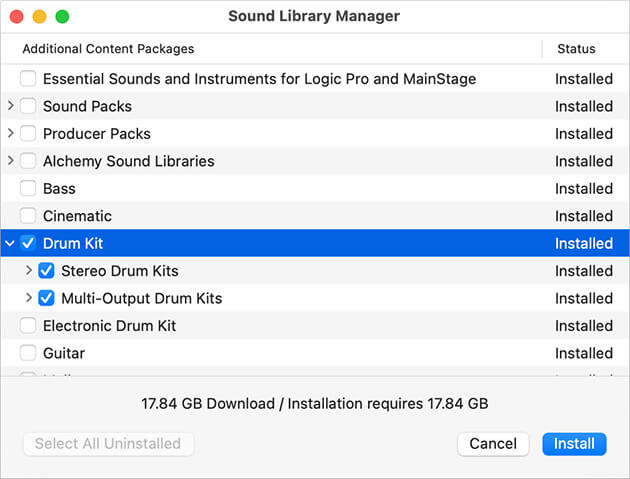 ©Logic Pro
©Logic ProThe Sound Library Manager
Building custom kits with Drum Kit Designer
The Drum Kit Designer software instrument is automatically added to drummer tracks that use acoustic drummer characters. To open Drum Kit Designer, follow these steps:- Select a drummer track and display the inspector by choosing View → Show Inspector (I). The inspector opens to the left of the tracks area.
- Click the instrument slot in the channel strip. The Drum Kit Designer software instrument opens, as shown in the figure below.
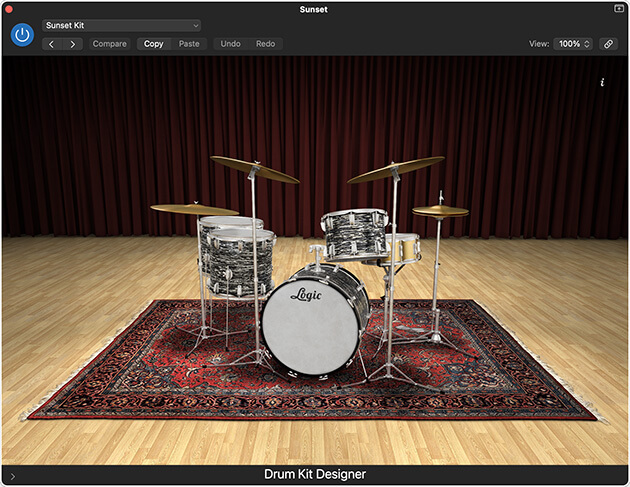 ©Logic Pro
©Logic ProDrum Kit Designer
Click any drum to play it. As you click a drum, the left side displays the Exchange panel where you can choose different drums. The right side displays the Edit panel, where you can control the selected drum sound.
Each type of drum or cymbal has different parameters. You can tune and dampen every sound and adjust the volume by using the Gain knob. If you've loaded a producer kit (refer to the preceding section, “Selecting producer kits”), you can select whether the sound should be included in the overheads and room microphones or should leak into other drum mics. You can select between two mic setups for the room mics by using the A/B slider.
At the bottom of the software instrument screen is a disclosure triangle that opens the additional settings shown in the figure above. In this area, you can adjust the volume of the drummer's percussion instruments.
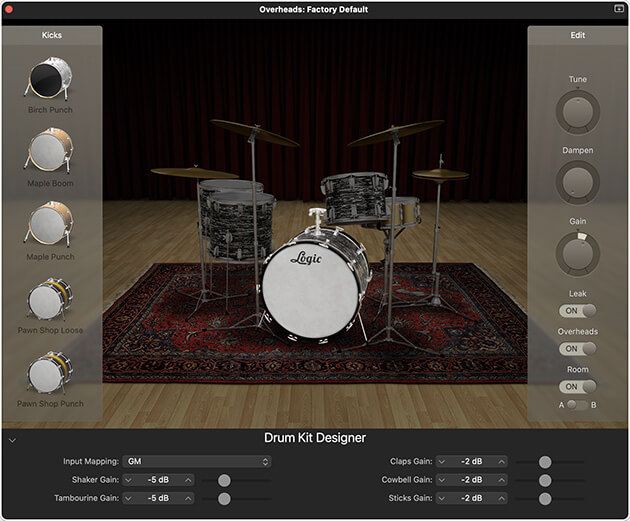 ©Logic Pro
©Logic ProDrum Kit Designer Exchange and Edit panels





